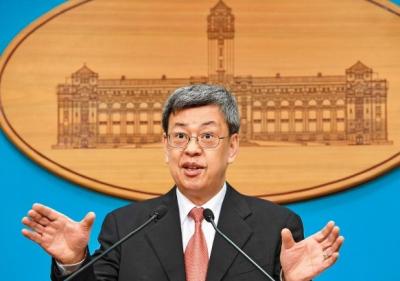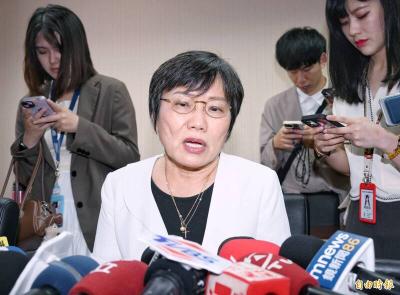The US does not see any connection between how China handles its trade relations with Taiwan and the nation’s chances of being admitted to the Trans-Pacific Partnership (TPP), visiting US Department of State senior official for APEC affairs Robert Wang said yesterday.
“[When] we look at Taiwan’s membership in the TPP, we will be asking Taiwan what areas you are willing to open up [to TPP members] on its own, unrelated to which areas Taiwan opens to China. That’s another issue,” Wang said at a roundtable discussion with local press in Taipei.
Wang was the second US official unambiguously stating that cross-strait relations will not affect the US’ stance on Taiwan joining TPP negotiations, after the cross-strait service trade agreement was recently stalled in the legislature as a result of massive opposition from the public to the agreement.
American Institute in Taiwan (AIT) spokesperson Mark Zimmer said on April 10 that there was no direct connection between the two issues in response to media inquiries.
William Stanton, director of the Center for Asia Policy at National Tsing Hua University and former AIT director, said in an interview published yesterday that he did not see the possibility that the US would decide not to move forward with Taiwan’s inclusion on account of any objection from China.
Despite the comments from the US, Minister of Economic Affairs Chang Chia-juch (張家祝) reiterated that China could negatively affect the nation’s chances of joining the TPP because China is the biggest or second-biggest trade partner for most of the 11 other TPP members, although the US may not consider the Economic Cooperation Framework Agreement (ECFA) a necessary step.
Asked to respond to Chang, Wang said the US does not see the ECFA as a requirement for Taiwan’s membership in the TPP.
“If Taiwan wants to join or [an]other country wants to join the TPP, that [the country’s relationship with China] is not one of the criteria. We will evaluate anyone’s interests in joining the TPP based on TPP standards and on whether the country would be a positive factor when it joins the TPP, in terms of promoting trade and greater liberalization,” Wang said.
Asked about China’s leverage on other TPP members with regard to Taiwan’s accession to the TPP talks, Wang said he cannot speak for other countries.
Wang said when the US started preparations for the TPP negotiations about two years ago, China was reportedly unhappy because it thought the US initiative was aimed at excluding Beijing.
“That did not stop the TPP from going. How China sees something is not what the TPP is concerned [about]. The TPP focuses on liberalization, ruled-based system, and was to make sure it benefits those who want to join the TPP when it expands,” the US official said.

Taiwan would welcome the return of Honduras as a diplomatic ally if its next president decides to make such a move, Minister of Foreign Affairs Lin Chia-lung (林佳龍) said yesterday. “Of course, we would welcome Honduras if they want to restore diplomatic ties with Taiwan after their elections,” Lin said at a meeting of the legislature’s Foreign Affairs and National Defense Committee, when asked to comment on statements made by two of the three Honduran presidential candidates during the presidential campaign in the Central American country. Taiwan is paying close attention to the region as a whole in the wake of a

President William Lai (賴清德) has appointed former vice president Chen Chien-jen (陳建仁) to attend the late Pope Francis’ funeral at the Vatican City on Saturday on his behalf, the Ministry of Foreign Affairs said today. The Holy See announced Francis’ funeral would take place on Saturday at 10am in St Peter’s Square. The ministry expressed condolences over Francis’ passing and said that Chen would represent Taiwan at the funeral and offer condolences in person. Taiwan and the Vatican have a long-standing and close diplomatic relationship, the ministry said. Both sides agreed to have Chen represent Taiwan at the funeral, given his Catholic identity and

Chinese Nationalist Party (KMT) Chairman Eric Chu (朱立倫), spokeswoman Yang Chih-yu (楊智伃) and Legislator Hsieh Lung-chieh (謝龍介) would be summoned by police for questioning for leading an illegal assembly on Thursday evening last week, Minister of the Interior Liu Shyh-fang (劉世芳) said today. The three KMT officials led an assembly outside the Taipei City Prosecutors’ Office, a restricted area where public assembly is not allowed, protesting the questioning of several KMT staff and searches of KMT headquarters and offices in a recall petition forgery case. Chu, Yang and Hsieh are all suspected of contravening the Assembly and Parade Act (集會遊行法) by holding

Lawmakers from the Democratic Progressive Party (DPP) yesterday established a friendship group with their counterparts in Ukraine to promote parliamentary exchanges between the two countries. A ceremony in Taipei for the Taiwan-Ukraine Parliamentary Friendship Association, initiated by DPP Legislator Chen Kuan-ting (陳冠廷), was attended by lawmakers and officials, including Deputy Minister of Foreign Affairs Francois Wu (吳志中) and European Economic and Trade Office in Taiwan Director Lutz Gullner. The increasingly dire situation in Ukraine is a global concern, and Taiwan cannot turn its back when the latter is in need of help, as the two countries share many common values and interests,